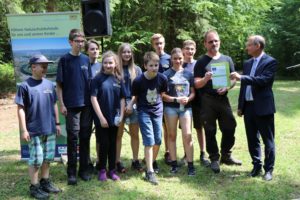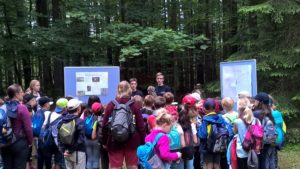#HabitatHeroes Pioneers from the Bavarian Forest National Park
Meet our #HabitatHeroes: Junior Rangers of the Bavarian Forest National Park

The Bavarian Forest National Park is the oldest national park in Germany. It is a largely forested medium-range mountain landscape which is highly characteristic for Central Europe. Thanks to the Park management that aims to protect natural processes, the forest has seen a successful reintroduction of the ural owl.
Tell us all about your “natural treasure”: Which is the species or habitat you learn and work with the most in your Protected Area?
Founded in 1970, the Bavarian Forest National Park has the task of preserving this valuable region as well as its natural and near-natural ecosystems as a place of natural heritage for current and future generations. The National Park is covered by around 98 percent forest. This includes mixed mountain forests, mountain spruce forests and alluvial spruce forests. In addition, the Bavarian Forest National Park also contains peatlands, open rock faces and historic high-level pastures. In the National Park, the aim is to protect the natural process of genesis, growth and decay. This also includes allowing trees fallen by storms or bark beetles to remain part of the natural cycle. This not only offers extra light, it also adds valuable structure to the forest. As a result, many sometimes highly endangered species can enjoy improved living conditions and/or more abundant sources of food. The gaps in the canopy also ensure that the next generation of forest flora can develop according to its own ancient laws – in turn allowing the pristine forest of tomorrow to emerge.Therefore, the National Park is home to thousands of species.
What is special about it?
One of these species is the ural owl (Strix uralensis). In the area of the Bavarian Forest, the ural owl went extinct in 1925. Thanks to the reintroduction attempts in the Bavarian Forest National Park since 1975, several breeding pairs are again native in the park with numbers steadily increasing. The administration also installed large nesting boxes. The loss of natural breeding opportunities and hunting were the main reasons for the disappearance of the species in the Bohemian Forest. Ural owls need large broken and decomposing tree trunks in mixed mountain forests. Today, these can only be found on a small scale in areas with very old trees. Within the park area, these structures are emerging again and in 1989, the first breeding pair nested on a broken tree trunk. Nevertheless, the national park administration still installs nesting boxes for ural owls which are also used by other bird species.

Describe to us what you and your fellow Junior Rangers are doing/will do to learn more and protect your natural treasure. Do you even teach others?
This year marked the 40th anniversary of the EU Birds Directive. To mark this anniversary, several events took place. The National Park hosted an event specially dedicated to the ural owl and the Junior Rangers prepared information material for the guests and politicians.
To do so, we had several meetings before the big event. We started in spring with a calling survey. We met in the evening and discussed the various owls living in the national park and listened to their calls. When it got dark, we drove to various places in the park and played their calls over a loudspeaker, listening for answers. And we were lucky! An ural owl answered.
In the next meeting, we discussed their habitat and built a nesting box for ural owls. The nesting box features three holes one to the front and two at the sides of the box so that the adult owl can look for potential dangers. It also features a mirror on the ceiling of the box so that researchers can have a safe look into the box without disturbing the animals.
Next up, we even got to participate in the ringing of young ural owls! Ringing them helps us identify the individual owls later on.
In the last meeting, we prepared some information material and a plan for the big event.
At the event, we had four stations where we showed the guests the nesting boxes and bird preparations as well as loudspeakers with their sounds and explained about the ural owl and its habitat. We were honoured as NATURA2000 ambassadors and received a certificate for our efforts to inform and protect NATURA2000 habitats and species.
________________________________________________________________
How to learn more and keep track of #HabitatHeroes campaign activities?
Since 2018 we are “mapping the field” and raising awareness for the great work Junior Ranger groups are currently doing for threatened flora, fauna and habitats in Protected Areas and Natura 2000 sites in particular.
- Visit the “Habitat Heroes” campaign website: For now, we are thrilled to introduce you to our Habitat Hero campaign pioneers – groups already taking action. You will find a growing map and overview of Junior Ranger groups.
- Besides, you will meet our “Habitat Heroes” in dedicated articles – make sure you follow our news!
- Keep an eye on social media – the #HabitatHeroes will provide you with exciting updates from our Junior Ranger groups that take part in the campaign. Don’t forget to share their actions!
Want to join the campaign? We are happy to learn about your conservation action – just drop us a mail: f.minozzi@europarc.org